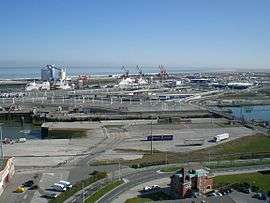Port of Calais
The Port of Calais is a port in Calais, northern France.[1] The port is the fourth largest port in France and the largest for passenger traffic. It accounts for more than a third of economic activity in the town of Calais.



Background
The Port of Calais was the first cable ship port in Europe and is the fourth largest port in France and the largest for passenger traffic.[2]
After the Treaty of Le Touquet was signed by France and the UK on 4 February 2003, juxtaposed controls were established in the port.[3][4] Passengers travelling from the port to Dover, UK go through French exit checks (conducted by the French Border Police and French Customs) as well as UK immigration entry checks (by the UK Border Force) before embarkation. UK Border Force officers have the power to arrest and detain individuals in the immigration control zone in the port.[5] Customs checks remain unaffected by the Treaty. Therefore, on arrival in Dover, travellers might still be stopped by UK Border Force customs officers for a customs inspection.[6]
Marine transport
As of August 2019, only two companies operate regular scheduled services to Calais - DFDS Seaways and P&O Ferries - both operating exclusively on the run between Calais and Dover from this harbour. There is the potential, however, that a third company could join the current duopoly between the two companies in the foreseeable future.
Traffic
Cargo traffic has tripled over the past two decades. In 2007 more than 41.5 million tonnes of traffic passed through Calais with some 11.52 million passengers, 1.4 million trucks and trailers, 2.249 million cars and 4,700 crossings a year.[2] On average, ships sail from the port every 30 minutes.[2] Most of the traffic in Calais comes from the Port of Dover.
Expansion
In 2015, A new 400 million euro project was underway at the port to create a breakwater protecting a pool of 700 metres long, thus allowing Calais to have the capability to handle vessels of all shapes and sizes, from the smallest private yachts to supersize cruise ships, like the Oasis-class cruise ships.[7][8]
Access
Buses connect the port with Gare de Calais-Ville on the SNCF network. There are regular TER Nord-Pas-de-Calais trains through Hazebrouck to Lille Flandres (for SNCB/NMBS into Belgium, for example to Gent-Sint-Pieters), Calais-Fréthun, Boulogne, as well as along the coast via Gravelines to Dunkerque.
There are also direct TGV trains which run from Gare de Calais-Ville then via Calais-Fréthun (served by Eurostar) to Lille-Europe and Paris Gare du Nord.
See also
References
Notes
- "Port Boulogne Calais : Ferry pour l'Angleterre". www.calais-port.fr.
- "Calais". Nord France Invest. Retrieved 10 February 2012.
- "Approbation du traité entre le Gouvernement de la République française et le Gouvernement du Royaume-Uni de Grande-Bretagne et d'Irlande du Nord relatif à la mise en oeuvre de contrôles frontaliers dans les ports maritimes de la Manche et de la mer du Nord". Sénat (in French). Retrieved 5 July 2016.
- "Treaty between the Government of the United Kingdom and the Government of the French Republic concerning the implementation of frontier controls at sea ports of both countries on the Channel and North Sea" (PDF). Channel 4. Archived from the original (PDF) on 20 April 2016. Retrieved 5 July 2016.
- "The Nationality, Immigration and Asylum Act 2002 (Juxtaposed Controls) Order 2003", legislation.gov.uk, The National Archives, SI 2003/2818
- "An Inspection of Juxtaposed Controls (November 2012 - March 2013)" (PDF). Independent Chief Inspector of Borders and Immigration. 8 August 2013. para 4.2. Retrieved 28 March 2020.
- "CALAIS PORT 2015 BREAKWATER IS NOW 685 METERS LONG !". Société des Ports du Détroit (SPD). 31 October 2016. Retrieved 24 January 2018.
- "Bouygues chooses Xblocs for Calais breakwater". www.theconstructionindex.co.uk. 23 February 2016. Retrieved 24 January 2018.
Bibliography
- Hendy, John (1988). Sealink Dover–Calais. Staplehurst, Kent: Ferry Publications. ISBN 0951350617.
- Hendy, John (2009). Dover-Calais: The Short-Sea Route. Ramsey, Isle of Man: Ferry Publications. ISBN 9781871947939.
- Hendy, John (2016). Dover-Calais. Ramsey, Isle of Man: Ferry Publications. ISBN 9781906608743.
- Paterson, J.D. (1894). By Dover and Calais from early times to the present day. Dover: Printed at the "King's Arms" Printing Works. OCLC 12041086.
- Spiers, Derek (1998). Troopships to Calais: the story of Calais as a military port from 1944 to 1947 and the ships which served it. Rainham, Kent: Meresborough Books. ISBN 0948193395.